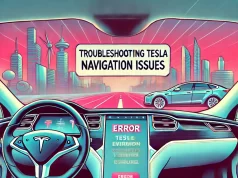Have you ever walked up to your Tesla, expecting it to unlock automatically as you reach for the door handle, only to find that nothing happens?
Have you ever wondered why your Tesla passive entry feature, which is supposed to make your life easier, suddenly stops working? If so, you are not alone.
Many Tesla owners have experienced this issue at some point, and it can be very annoying and frustrating.
In this article, we will explain what Tesla’s passive entry is, how it works, why it may not work, and how to fix it.
By the end of this article, you will have a better understanding of this feature and how to troubleshoot it if it fails.
Why Tesla Passive Entry Greyed Out?
#1. Low battery in the key fob
One of the most common reasons for passive entry not working is that the battery in the key fob is low or dead.
You can check the battery level by pressing the top button on the key fob and looking at the LED indicator. If it flashes green, the battery is good; if it flashes yellow, the battery is low; if it flashes red, the battery is dead.
You can replace the battery with a CR2032 coin cell battery by following the instructions in the owner’s manual.
#2. Faulty micro switch in the driver’s door handle
Another possible cause for passive entry not working is that the microswitch that senses the press of the driver’s door handle is faulty or broken.
This can prevent the car from detecting your presence and unlocking the door. You can test this by trying to press the other door handles or the trunk button and see if they work.
If they do, then the problem is likely with the driver’s door handle microswitch. You may need to contact Tesla service to get it fixed.
#3. Software glitches or update
Sometimes, passive entry may stop working due to a software glitch or update that affects the communication between the car and the key fob. This can happen randomly or after installing a new software version.
You can try to fix this by rebooting the car and the key fob, or by updating or reprogramming the key fob. To reboot the car, press and hold both scroll buttons on the steering wheel until the touchscreen turns black and restarts.
To reboot the key fob, press and hold both buttons on it until it flashes rapidly. To update or reprogram the key fob, follow these steps:
- Enter PIN to drive if enabled
- Go to Settings > Security
- Put the car in Drive
- Put the car in Park
- The passive Entry switch should be activated and can be switched on again
- If not, place the key fob on top of the cup holder and press Start Software Update
If no update is available or no fob is found, you may need to take your key fob (and all others) to a Tesla service center to reprogram them.
#4. Interference from other devices or metal objects
Sometimes, passive entry may not work because of interference from other devices or metal objects that are near your key fob or your car. These can include cell phones, laptops, chargers, RFID cards, magnets, coins, keys, etc.
These can block or weaken the signal between your key fob and your car, preventing them from recognizing each other.
You can try to avoid this by keeping your key fob away from these sources of interference, or by using a Faraday pouch or case to shield your key fob from unwanted signals.
Tesla passive entry is a useful feature that makes accessing your car easier and faster. However, if it stops working, you may face some inconvenience or frustration.
Fortunately, there are some simple ways to troubleshoot and fix this issue, such as checking your key fob battery, testing your door handle microswitch, rebooting or updating your key fob, or avoiding interference from other devices or metal objects.
How To Fix Tesla Passive Entry Greyed Out?
#1. You need to enter a PIN to drive
If you have enabled PIN to drive, a security feature that requires you to enter a four-digit code before driving, you need to enter the PIN before you can change the passive entry setting. You also need to press the brake pedal to power the car.
#2. You need to shift to Drive and back to Park
Some users have reported that shifting the car to Drive and then back to Park can activate the passive entry switch and make it selectable again. This may be a bug or a way to prevent accidental changes while driving.
#3. You need to reboot the car or the key fob
Sometimes, a software glitch or update may cause the passive entry setting to be greyed out or not working properly.
You can try to reboot the car by pressing and holding both scroll buttons on the steering wheel until the touchscreen turns black and restarts.
You can also reboot the key fob by pressing and holding both buttons on it until it flashes rapidly.
#4. You need to update or reprogram the key fob
If none of the above methods work, you may need to update or reprogram your key fob, especially if you have an older model.
To update your key fob, place it on top of the cup holder and press Start Software Update on the touchscreen.
If no update is available or no fob is found, you may need to take your key fob (and all others) to a Tesla service center to reprogram them.
I hope this answer was helpful to you. If you have any questions or feedback, please let me know.
If none of these work, you may need to contact Tesla service for assistance.




